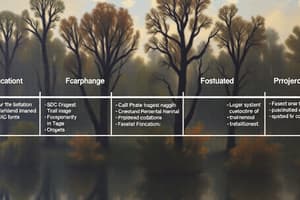Podcast
Questions and Answers
Which of the following is NOT a 'Super tool' for project success?
Which of the following is NOT a 'Super tool' for project success?
- Requirements analyses
- Scope statements (correct)
- Lessons-learned reports
- Software for task scheduling
What are the top three reasons for Federal Technology Project success?
What are the top three reasons for Federal Technology Project success?
- Excessive funding, underqualified staff, lack of stakeholder engagement
- Adequate funding, lack of staff expertise, no stakeholder engagement
- Limited funding, inexperienced staff, lack of stakeholder engagement
- Adequate funding, staff expertise, engagement from all stakeholders (correct)
In the Three Sphere Model for Systems Management, which spheres are typically considered?
In the Three Sphere Model for Systems Management, which spheres are typically considered?
- People, Process, Technology (correct)
- Quality, Risk, Communications
- Scope, Time, Cost
- Earth, Wind, Fire
What type of organization structure involves functional managers reporting directly to the CEO?
What type of organization structure involves functional managers reporting directly to the CEO?
What is the main characteristic of a Matrix organization structure?
What is the main characteristic of a Matrix organization structure?
Which of the following is NOT one of the basic organization structures mentioned?
Which of the following is NOT one of the basic organization structures mentioned?
'Lessons-learned reports' are considered 'Super tools' for project success. What is the primary purpose of these reports?
'Lessons-learned reports' are considered 'Super tools' for project success. What is the primary purpose of these reports?
Study Notes
Project Life Cycle
- A project life cycle is a collection of project phases that defines what work will be performed, what deliverables will be produced, and when, who is involved, and how management will control and approve work.
- A deliverable is a product or service produced or provided as part of a project.
Systems Development Life Cycle (SDLC)
- SDLC is a framework for describing the phases involved in developing and maintaining information systems.
- Types of SDLC:
- Predictive life cycle: scope of the project can be clearly articulated and the schedule and cost can be predicted.
- Adaptive Software Development (ASD) life cycle: requirements cannot be clearly expressed, projects are mission driven and component-based, using time-based cycles to meet target dates.
SDLC Models
- Predictive Life Cycle Models:
- Waterfall model: has well-defined, linear stages of systems development and support.
- Spiral model: shows that software is developed using an iterative or spiral approach rather than a linear approach.
- Incremental build model: provides for progressive development of operational software.
- Prototyping model: used for developing prototypes to clarify user requirements.
- Rapid Application Development (RAD) model: used to produce systems quickly without sacrificing quality.
Project Management Process
- A process is a series of actions directed toward a particular result.
- Project management process groups:
- Initiating processes
- Planning processes
- Executing processes
- Monitoring and controlling processes
- Closing processes
Scrum Roles
- Product owner: responsible for the business value of the project and decides what work to do and in what order, as documented in the product backlog.
Project Attributes
- A project has a unique purpose.
- A project is temporary.
- A project is developed using progressive elaboration.
- A project requires resources, often from various areas.
- A project should have a primary customer or sponsor.
- A project involves uncertainty.
Project Management
- Project management is the application of knowledge, skills, tools, and techniques to project activities to meet project requirements.
- Project managers strive to meet the triple constraint (project scope, time, and cost goals).
- Project managers facilitate the entire process to meet the needs and expectations of project stakeholders.
Triple Constraint
- Scope Goal
- Time Goal
- Cost Goal
Stakeholders
- Stakeholders are the people involved in or affected by project activities.
Knowledge Areas
- Project managers must have knowledge and skills in 10 knowledge areas:
- Project integration
- Scope
- Time
- Cost
- Quality
- Human resource
- Communications
- Risk
- Procurement
- Stakeholder management
Super Tools
- Super tools are those tools that have high use and high potential for improving project success.
- Examples of super tools:
- Software for task scheduling (such as project management software)
- Scope statements
- Requirements analyses
- Lessons-learned reports
Three Sphere Model for Systems Management
- The three spheres are:
- Business
- Organization
- Technology
Organization Structures
- Three basic organization structures:
- Functional: functional managers report to the CEO.
- Project: program managers report to the CEO.
- Matrix: middle ground between functional and project structures; personnel often report to two or more bosses; structure can be weak, balanced, or strong matrix.
Organizational Culture
- Organizational culture is a set of shared assumptions, values, and behaviors that characterize the functioning of an organization.
- Many experts believe the underlying causes of many companies' problems are not the structure or staff, but the culture.
Studying That Suits You
Use AI to generate personalized quizzes and flashcards to suit your learning preferences.
Description
Test your knowledge on project life cycles, phases, deliverables, and the Systems Development Life Cycle (SDLC), which is a framework for developing and maintaining information systems. Explore concepts like predictive life cycles and project management control.



